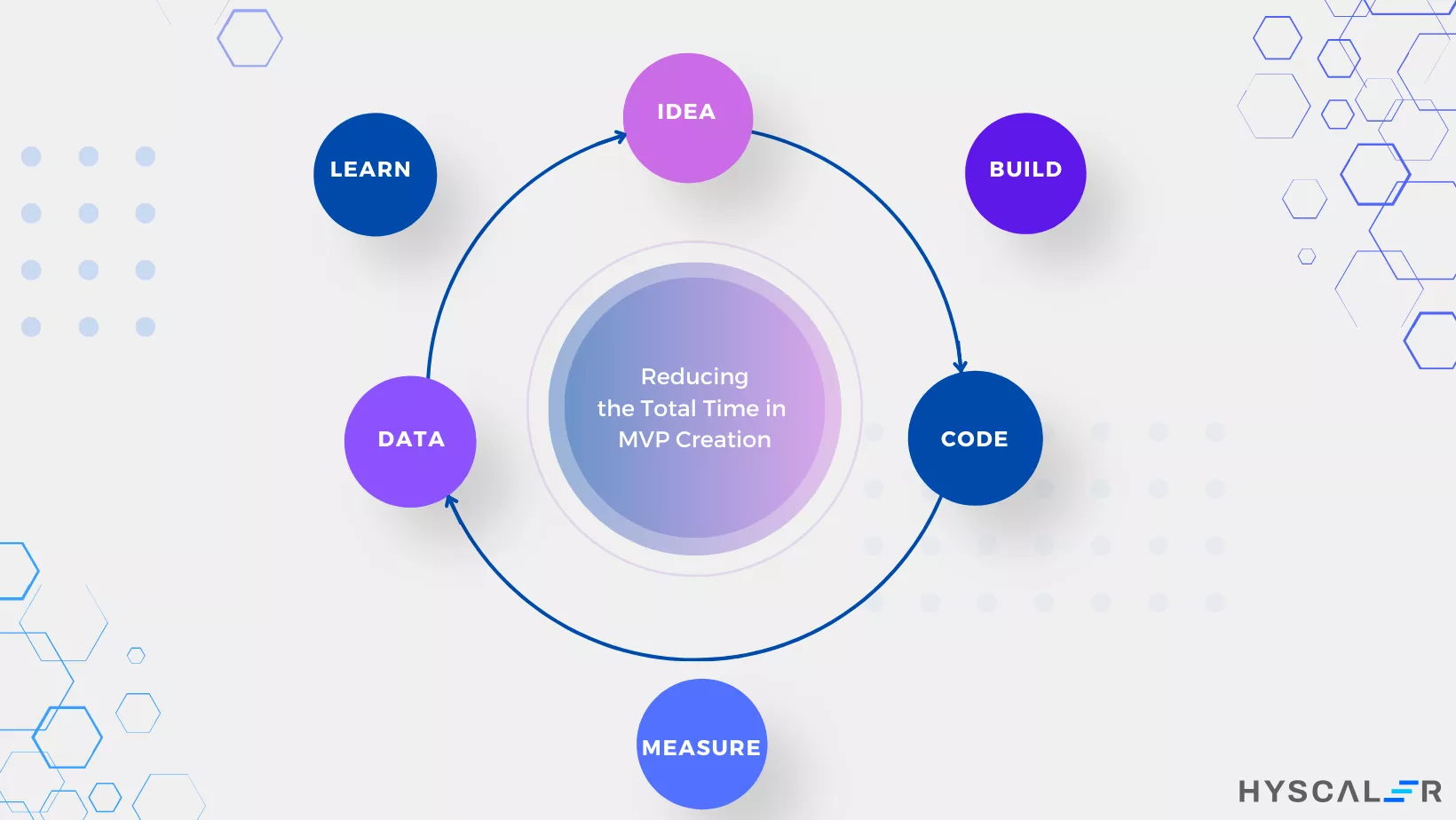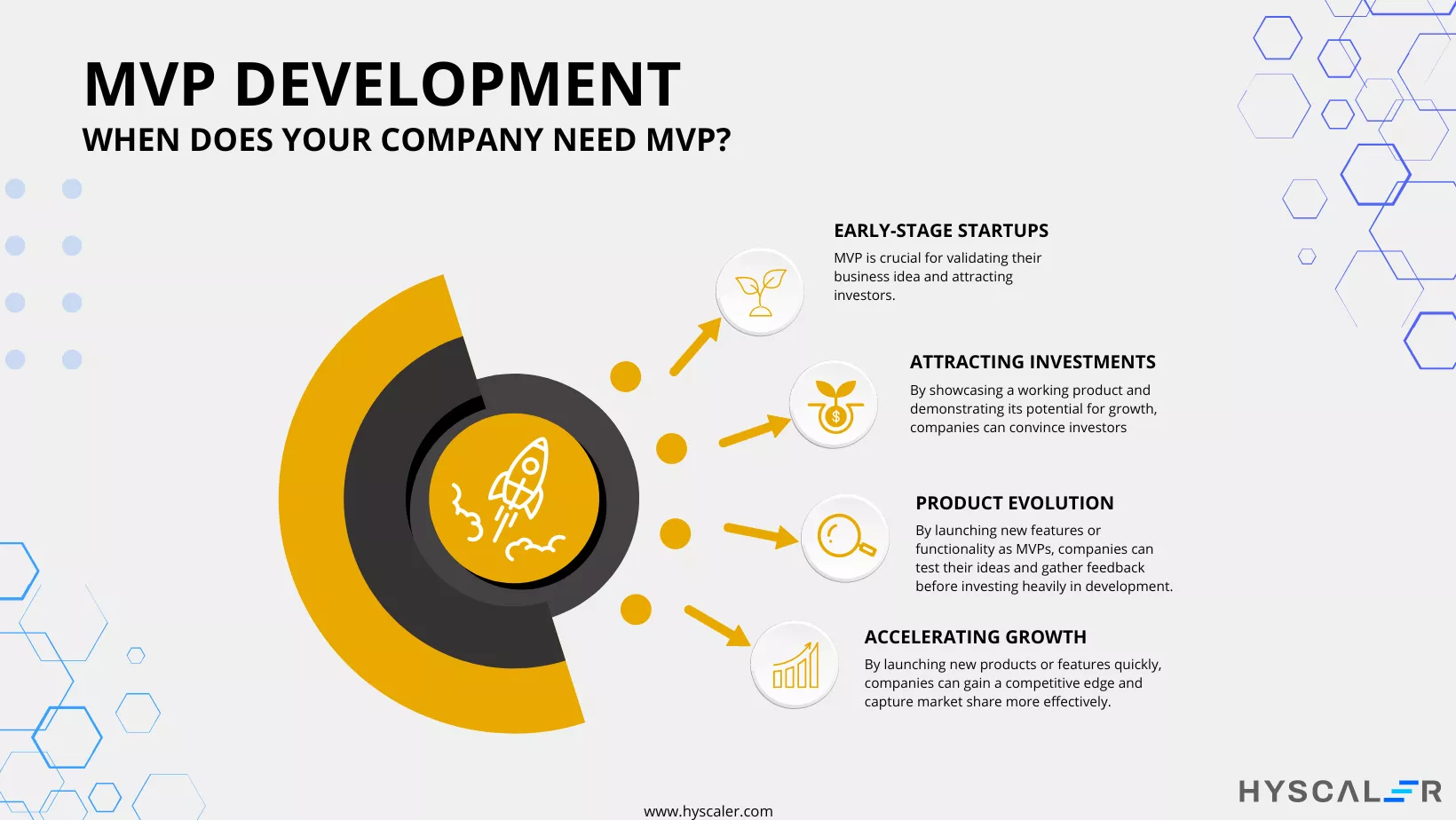Table of Contents
In today’s fast-paced business environment, success often hinges on reducing risks and maximizing the chances of success. One effective strategy is developing a Minimum Viable Product (MVP). An MVP is a simplified version of a product that includes only the core features necessary to satisfy early users and provide essential feedback for future development.
Why Build MVP?
The primary MVP benefit is that it allows businesses to test their product concepts early. By launching a version with essential features, companies can validate their ideas with real users, making it easier to pivot based on feedback. This approach helps in identifying the most engaged users and understanding their interactions with the product, providing critical insights without the need for extensive and costly changes.
MVP is said to be an important component of the Lean Startup Philosophy, where the company launches its ideas, thereby minimizing the risk of loss and failure.

Steps to Build MVP for Effective Business Growth
- Identify Customer Pain Points: Understand the problems faced by your target audience and how your product can solve them.
- Analyze the Competitive Landscape: Research competitors to find ways your product can stand out.
- Validate the MVP: Launch the MVP to early adopters and gather feedback to test your product idea.
- Prepare for Full Launch: Refine your product based on feedback and get ready for a broader launch.
The Purpose and Benefits of MVP
Creating an MVP allows businesses to validate their product ideas and gather valuable feedback. Here are the key benefits of MVP:
- Validating the Idea: MVP helps confirm whether your product concept resonates with the target audience and effectively addresses their pain points.
- Faster Time to Market: Focusing on core features reduces development time and costs, enabling quicker market entry.
- Data-Driven Insights: Businesses can make informed decisions about future developments by analyzing user behavior and feedback.
- Cost Efficiency: To build MVP requires fewer resources, saving time and money.
When to Consider Building an MVP
Build MVP strategies are particularly beneficial in various scenarios:
- Early-Stage Startups: For startups, MVP is crucial for validating business ideas and attracting investors by demonstrating a working product and user feedback.
- Investment Attraction: Established companies can also use MVPs to showcase growth potential and secure funding.
- Product Evolution: As products evolve, MVPs allow for testing new features and functionalities before full-scale development.
- Accelerating Growth: Quickly launching new products or features helps companies gain a competitive edge and capture market share.
Examples of Successful MVPs
Spotify: Launched in 2007, Spotify’s MVP included basic features like music streaming and playlist creation. Through continuous feedback and iteration, it became a leading music streaming service.
Uber: Uber’s 2010 MVP allowed users to request rides and track drivers. Focusing on core functionalities and user feedback enabled Uber to refine and expand rapidly.
Building MVP offers numerous benefits, including validating product ideas, faster market entry, and obtaining data-driven insights. This approach reduces risk, saves resources, and enhances the likelihood of creating a successful product. Whether you are a startup or an established business, the need to build MVP, strategies can significantly contribute to achieving your development and growth goals.
Why is MVP Important?
The biggest benefit of developing an MVP is that it allows you to test your business concepts. By offering the core set of features rather than a full-blown, feature-heavy product, you can verify that your product concept resonates with your target audience. This provides an opportunity to change a product’s direction based on your findings.
When the product is launched, you can identify the most active users and how they interact with the app. This information can be used to tailor app functionality to suit these users more. With a feature-heavy product, it would be much harder to change anything – you may even need to rebuild the entire app.
Setting Up an Effective MVP
To set up an effective MVP, it’s important to follow these key steps and follow some proven strategies:
- Identify the customer pain points: Understand the problems your target customers are facing and how your product can provide a solution.
- Describe the competitive landscape: Research your competitors and identify how your product can differentiate itself in the market.
- Test the MVP for validity: Launch your MVP and gather feedback from early adopters to validate your product idea.
- Get ready to launch: Based on the feedback, refine your MVP and prepare for a full-scale launch.
The Main Purpose of Creating MVP
The main purpose to build MVP is to validate your product idea and gather valuable feedback from early adopters. By launching a stripped-down version of your product, you can test your assumptions and make data-driven decisions about future development.
Validating the Idea
One of the primary benefits of MVP is validating your product idea. By launching a basic version of your product, you can gauge whether your target audience is interested in your offering and if it solves their pain points effectively.
Getting Faster to Market
Another key benefits of MVP is getting your product to market faster. By focusing on the core features and functionality, you can reduce development time and costs, allowing you to launch your product more quickly.
Getting Data-Driven Insights
Building an MVP provides valuable data and insights that can inform future development decisions. By analyzing user behavior and feedback, you can identify areas for improvement and prioritize features that will have the greatest impact on your product’s success.
When Does Your Company Need MVP?

There are several scenarios where building an MVP can be particularly beneficial for a company:
Early-Stage Startups
For early-stage startups, creating an MVP is crucial for validating their business idea and attracting investors. By demonstrating a working product and gathering user feedback, startups can build a strong case for their product and secure funding for further development.
Attracting Investments
To build MVP, it can help established companies attract investments. By showcasing a working product and demonstrating its potential for growth, companies can convince investors of the value of their offering and secure funding for expansion.
Product Evolution
As a product evolves over time, creating an MVP can help companies stay ahead of the curve. By launching new features or functionality as MVPs, companies can test their ideas and gather feedback before investing heavily in development.
Accelerating Growth
For companies looking to accelerate growth, building MVP can be a powerful tool. By launching new products or features quickly, companies can gain a competitive edge and capture market share more effectively.
What are Some Examples of MVPs?
Some well-known examples of successful MVPs include:
Spotify
Spotify launched its MVP in 2007 with a limited number of features, including the ability to stream music and create playlists. By gathering feedback from early adopters and iterating on the product, Spotify was able to grow rapidly and become one of the world’s leading music streaming services.
Uber
Uber launched its MVP in 2010 with a basic app that allowed users to request rides and track their driver’s location. By focusing on the core functionality and gathering feedback from early users, Uber was able to refine its product and expand into new markets quickly.
Dropbox
Dropbox’s MVP was a simple video demonstrating the functionality of its cloud storage solution. This video helped validate the concept and attract early adopters before the full product was developed.
Airbnb
Airbnb’s MVP was a simple website that allowed people to list their spaces for rent during a conference. This concept was validated quickly, leading to the development of the platform we know today.
What are Some Common Mistakes to Avoid When Creating an MVP
When building a Minimum Viable Product (MVP), avoiding common mistakes is crucial for success. Here are key mistakes to be mindful of during the process to build MVP:
- Lack of a Clear Product Strategy: Not having a well-defined marketing and sales plan or failing to identify your unique selling proposition can hinder your MVP’s success. It’s essential to understand how your product fits into the market and what differentiates it from competitors.
- Feature Overload: Including too many features in your MVP can dilute its core purpose and make it harder to gather meaningful feedback. Focus on the essential features that validate your product idea and address the primary pain points of your target audience.
- Overengineering: Building an overly complex MVP with unnecessary technical features can slow down development and increase costs. Keep it simple and focus on functionality that directly supports your business hypothesis.
- Ignoring Market Research and Testing: Skipping thorough market research and validation can lead to developing a product that doesn’t meet user needs or fit into the market. Understand your target audience and test your ideas before diving into development.
- Poor User Experience: Neglecting the user experience and interface design can result in an MVP that users find difficult to navigate or unattractive. A clean, intuitive design is essential for user adoption and feedback.
- Unrealistic Timelines and Budgets: Being overly optimistic about development timelines and costs can lead to delays and budget overruns. Set realistic expectations and allow for flexibility in your planning.
- Ignoring User Feedback: Failing to listen to feedback from early users and iterating accordingly can result in a product that doesn’t improve or evolve. User feedback is invaluable for refining your MVP and ensuring it meets market needs.
- Working with the Wrong Development Team: Having an inexperienced or unprofessional team can compromise the quality of your MVP. Choose a team with relevant experience and a proven track record in MVP development.
- Neglecting Scalability: Not designing the MVP with future growth in mind can create challenges when scaling. Ensure that your architecture can handle increased demand and additional features as your product evolves.
By focusing on these areas and avoiding these common pitfalls, you can increase the likelihood of developing a successful MVP that effectively validates your business idea and paves the way for future growth.
Conclusion
Building an MVP offers numerous benefits for businesses of all sizes and stages. By validating product ideas, getting to market faster, and gathering data-driven insights, companies can reduce risk, save time and resources, and ultimately create more successful products. Whether you’re a startup looking to attract investors or an established company looking to accelerate growth, creating an MVP is a powerful strategy that can help you achieve your goals more effectively.